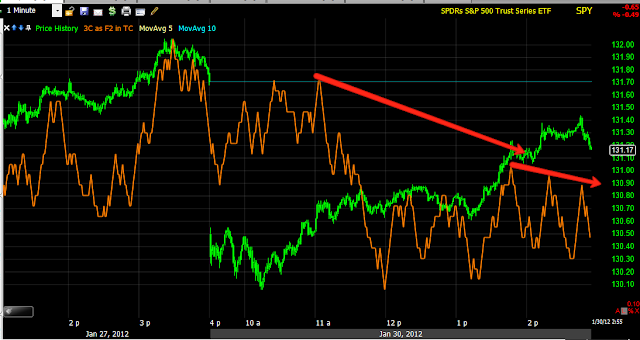I believe it also has to do with extremes in investor sentiment, which is most often a contrarian indicator, for example, when a high percentage of dumb money is bullish, it often marks a top in the market. As per last night' post, the bullish dumb money sentiment is very high and the bearish dumb money sentiment is very low. Human nature being what it is, a lot of traders will see a bullish market and feel like they missed it, so near the top, they tend to want to get involved, but do they buy quality stocks with high P/E ratios? Generally no, they look for a sale, something cheap as most investors think that the number of shares they can buy will increase their returns rather then focus on the percentage gain that can be achieved with a quality stock.
While PEIX may or may not be a stock that falls in to the above described category, it certainly is a C&D stock and these stocks can really move, albeit you are best off taking profits quick as they tend to evaporate just as quickly. That being said, I like PEIX's chances and a simple trade alert can offer a low risk trade with the chance of very high returns in a short period of time.
This is the long term PEIX daily chart, I wanted to show this example because it features a bullish ascending wedge. Almost all technical analysis books will tell you that when the wedge reaches its apex, there should be a bullish break out and the wedge should retrace its base, that would be a target of about $7.00. However after observing hundreds of these wedges, both bearish and bullish, I've noticed that they are a lot more likely to form a lateral base or top then they are to breakout. Some will even stage a false breakout/breakdown. PEIX is such an example. Note the lateral base, this kind of price action (or in action) is often an accumulation area. PEIX did make a run and has formed a bullish continuation triangle consolidation.
To illustrate the gains in these C&D trades, I took the average price during the accumulation period (it's actually around $.31) and have shown the move of 440% on an intraday high and 338% on a closing high, the point is, they can really run.
Here's that accumulation period.
After initial confirmation (green), there was profit taking/distribution (red), since we have seen some accumulation within the consolidation (white).

We saw a quick breakout (yellow box) and that saw distribution, so it was a head fake. Most amateur traders will give a trade one shot and if it doesn't work, they walk. Professional traders will give a good looking trade multiple shots as long as they keep their losses small, they can do this. This 5 min chart also shows some recent accumulation after the head fake move.
The 1 min chart confirms everything seen on the above chart.
A 3-day Trend Channel has held the major up and down trends, that would include a downtrend of -95% and an uptrend of up to 440%. The current Trend Channel stop would be $.93, which could be used, but a tighter stop can also work.
If we treat the entry as a swing trade entry, then Friday made the last lower low/lower high and is our pivot. The next candle (Today's) is the signal candle. The idea would be to go long on a breakout through the signal candle's highs ($1.06 is today's high, so a move to $1.07). Then simply place your stop just below at either the pivot or signal candle's low ($1.02 and $1.01 respectively), but we want to stay away from whole number stops as they are WAY too obvious for a shakeout/stop fishing expedition. I would consider a stop of $.97 or so.
Being a speculative trade, I wouldn't invest more then 10% of my total portfolio value before margin and maybe less.
For risk management and position sizing, lets assume a portfolio of $10,000 and our investment of 10% of portfolio ($1,000). At $1.07, lets call it $1.09 just for slippage, we can buy 917 shares. I like to keep my loss on any one trade at 2% of portfolio and on spec. trades, sometimes less, but lets assume 2% ($200). With a stop at $.97 and we'll call it $.95 for slippage, we have risk of $.14 (entry @ $1.09 /stop at $.95=$.14 accounting for slippage). Multiply $.14 (risk) by 917 shares and our risk on the trade is $128.38 which is about 1.2% of portfolio.
Our potential upside based on the consolidation and not past gains, is around $2.15, from an entry of $1.09 that's $1.06 in profit. So our reward:risk factor (which should never be less then 3:1) is about 7.5:1 or double our minimum r:r factor. That makes PEIX an interesting trade.

























































